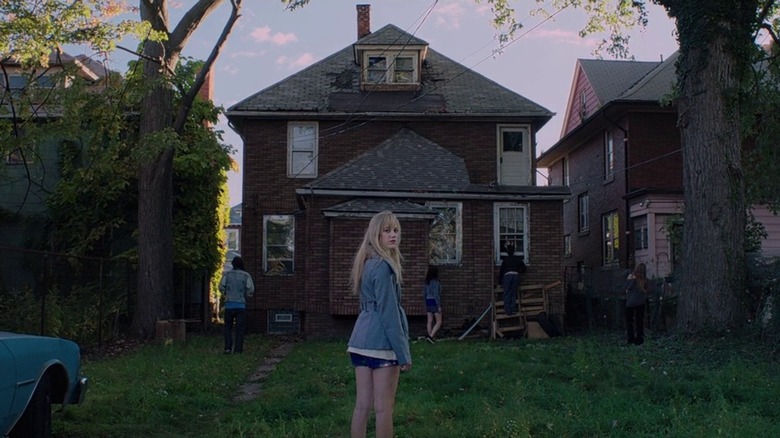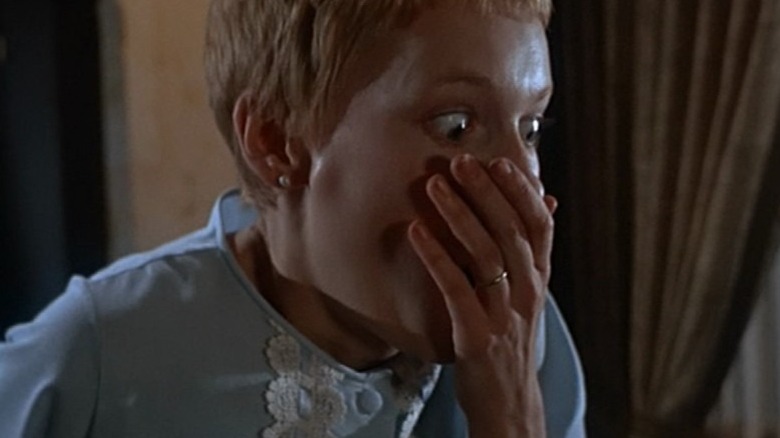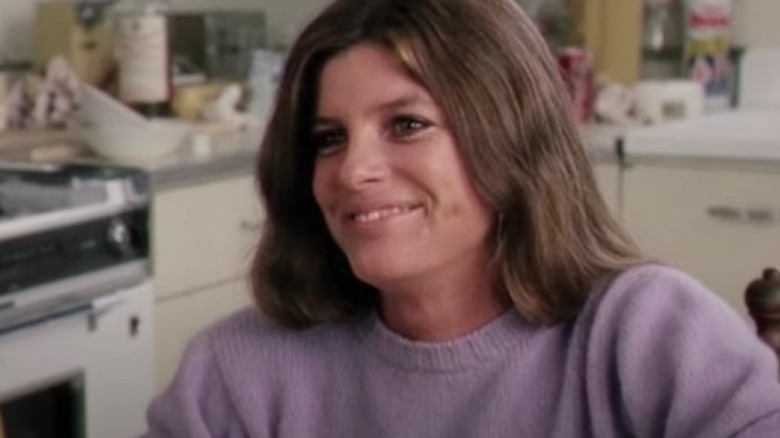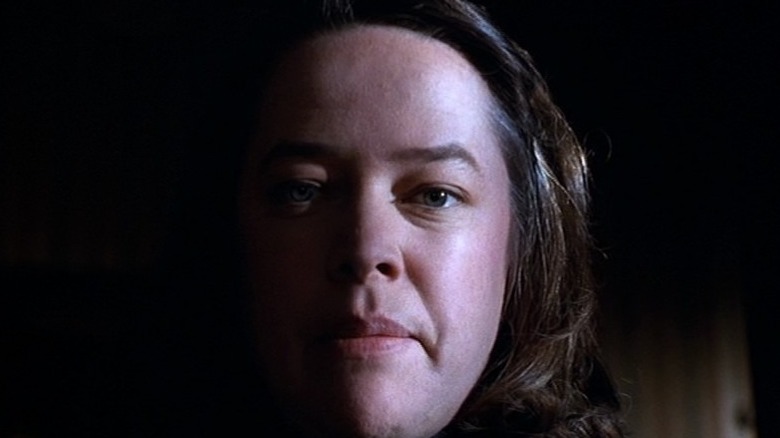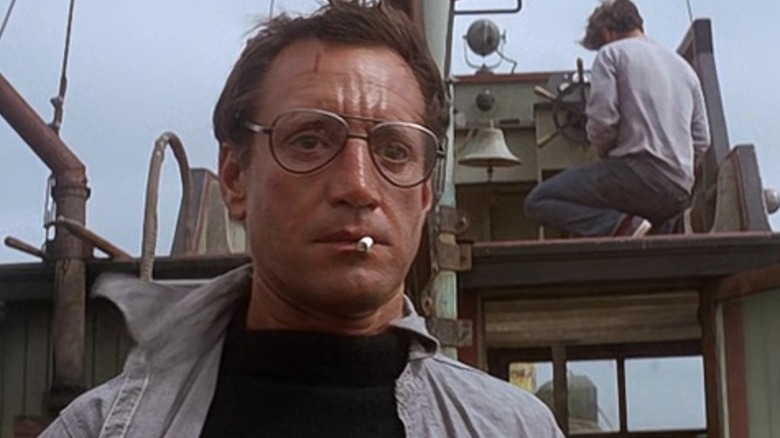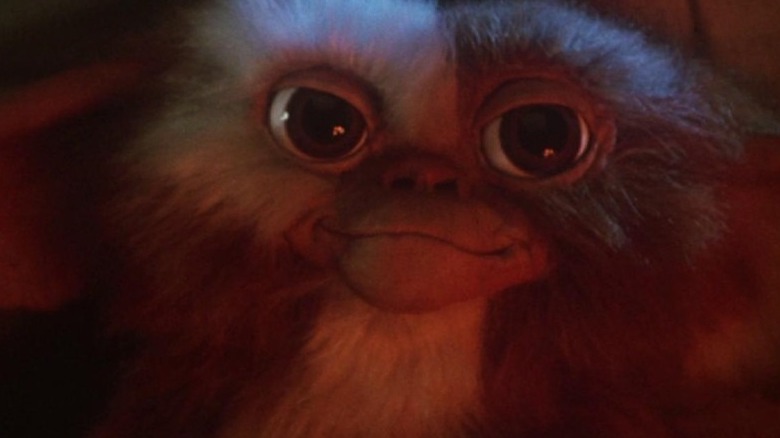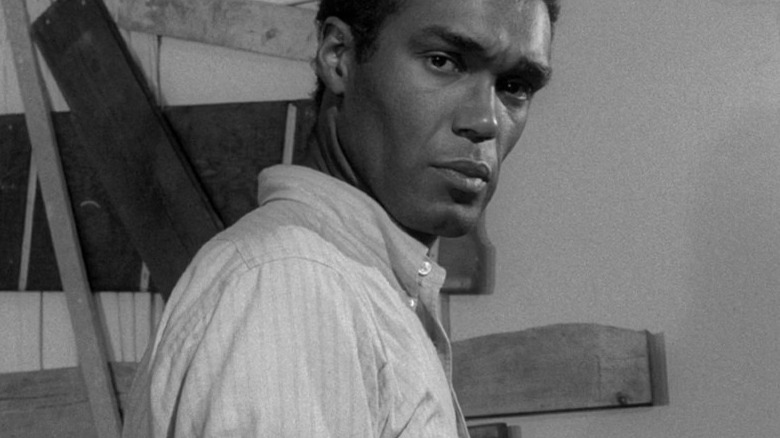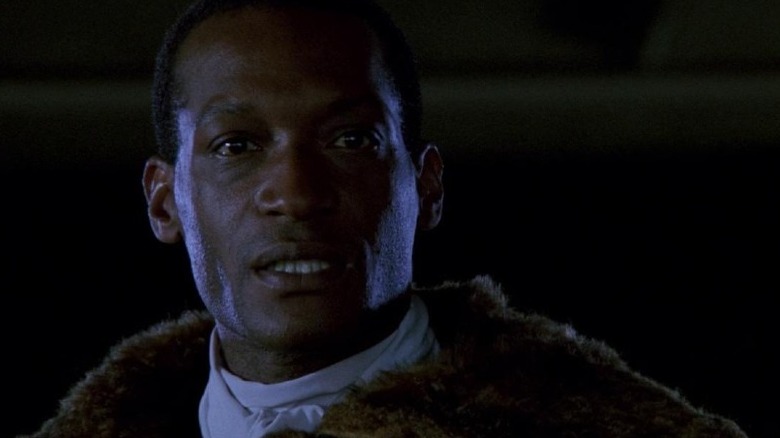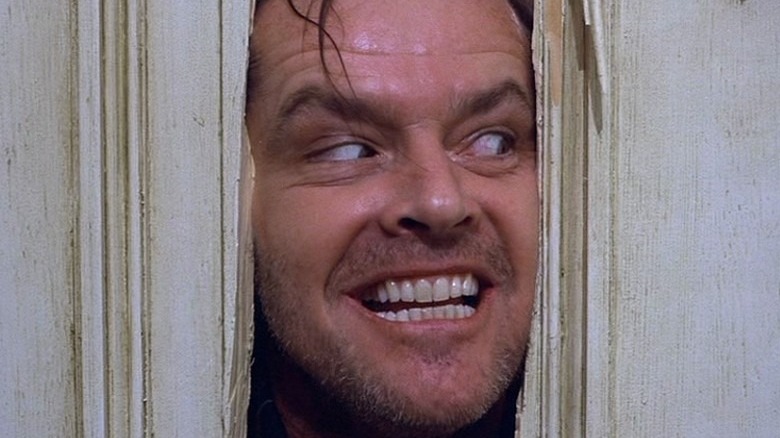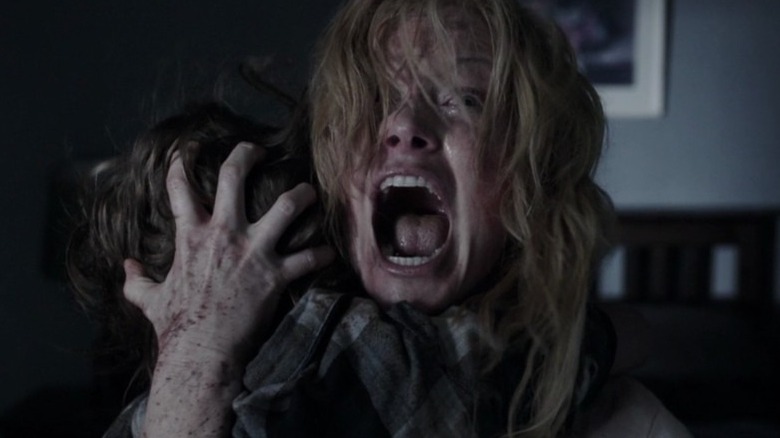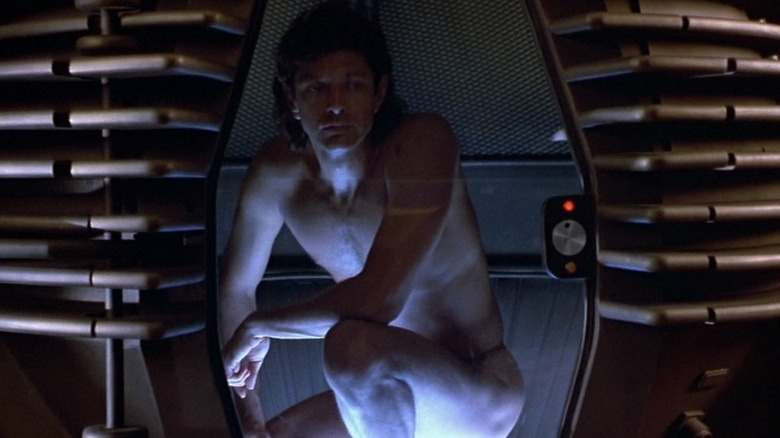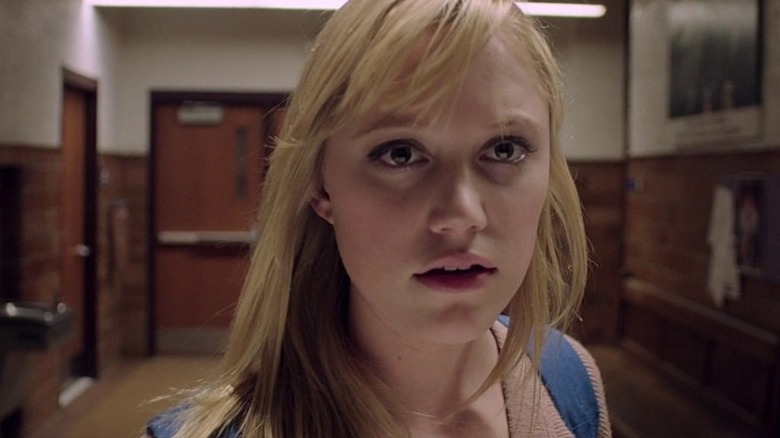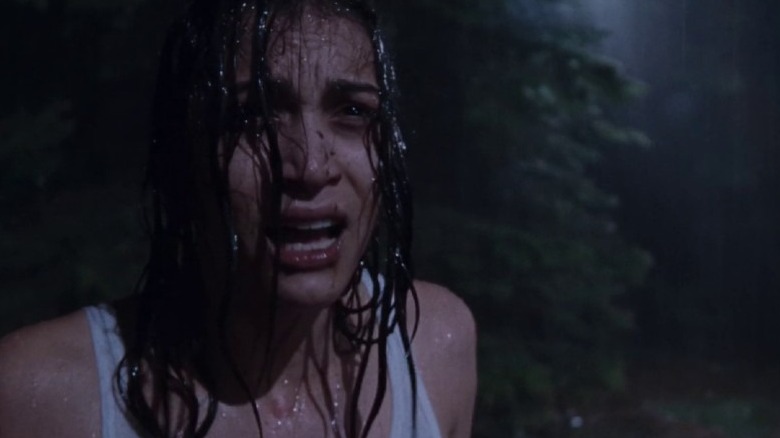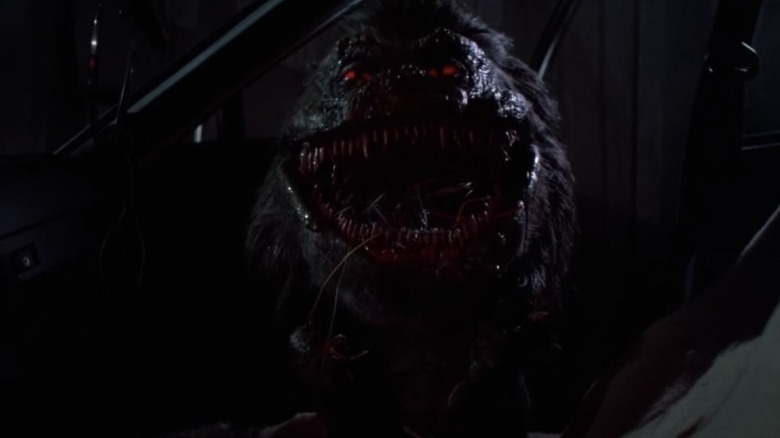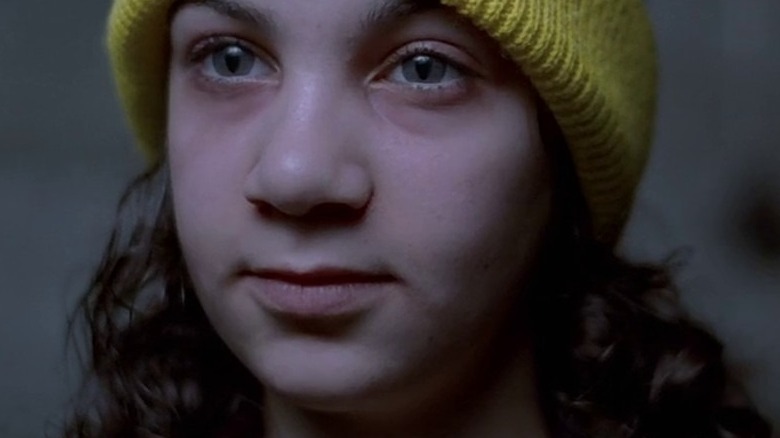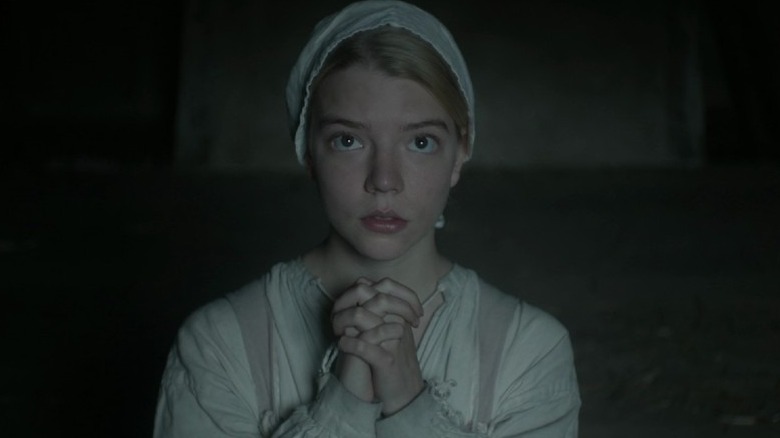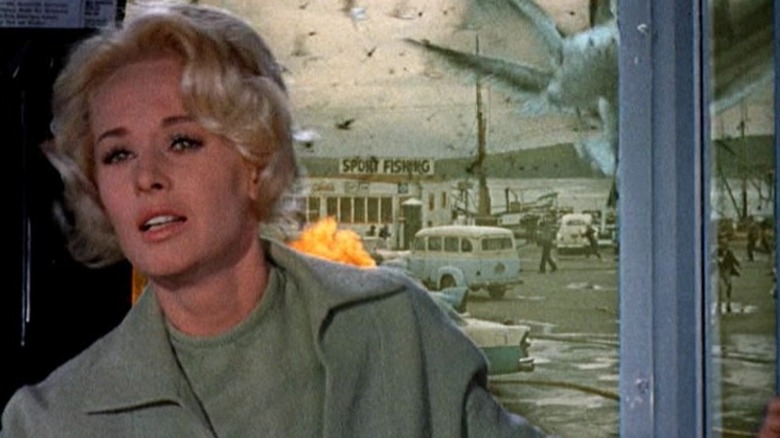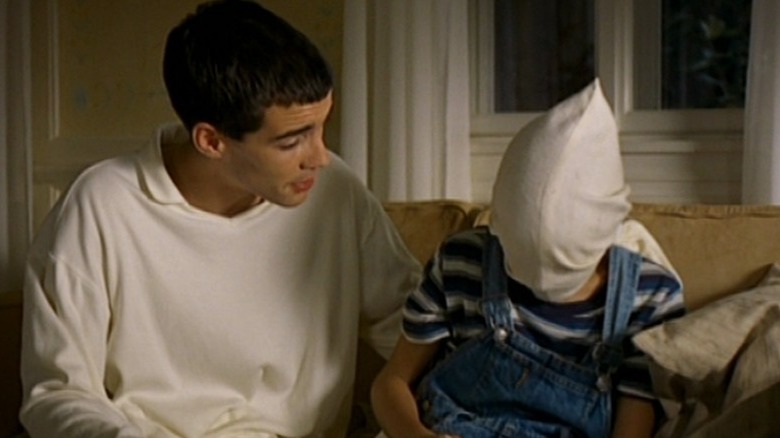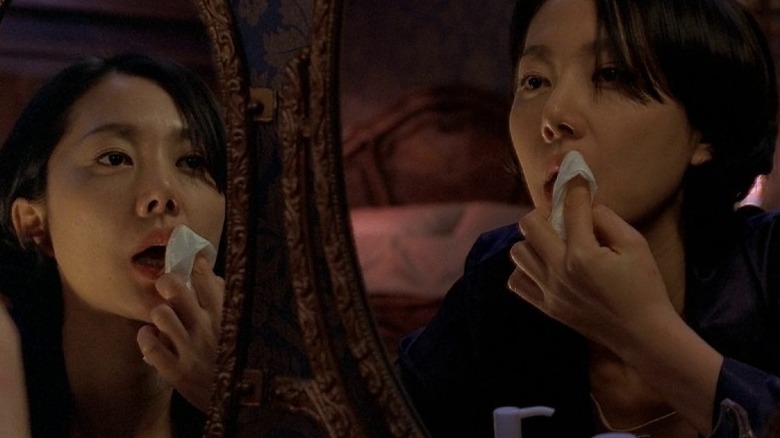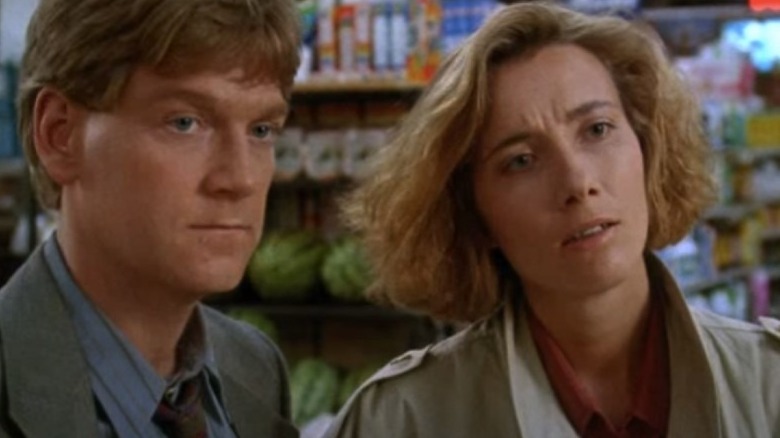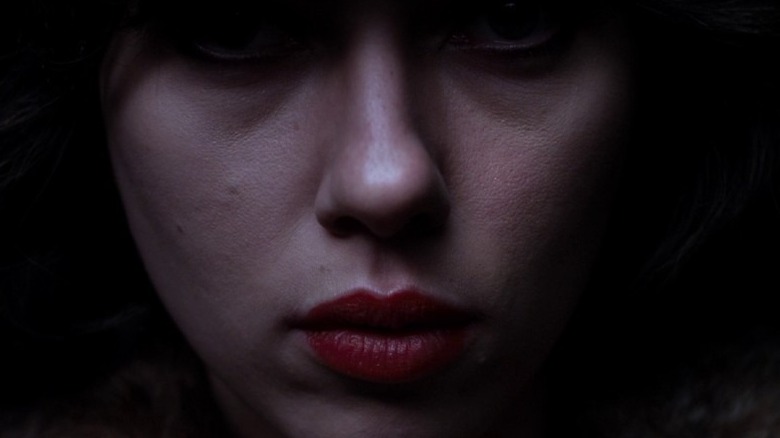Horror Movies Jordan Peele Thinks You Should Watch Next
We may receive a commission on purchases made from links.
Jordan Peele is a modern master of horror. That's an impressive feat given his small, yet mighty, directorial filmography to date. Alongside his two feature films "Get Out" and "Us," Peele reinvented the iconic "Twilight Zone" sci-fi series for a new generation and contributed to Nia DaCosta's "Candyman" in a writer role. His understanding of genre and skillset as a visual storyteller is nothing short of genius. His third genre feature is titled "Nope," starring Daniel Kaluuya, Keke Palmer, and Steven Yeun.
We scanned the internet and numerous interviews for Peele's must-watch horror films. Many on this list have greatly inspired his own work, from the frightful expertise of a Hitchcock classic to the slow-burning nature of modern fare. Others have simply left an indelible mark on his horror-loving mind or served as a gateway to the genre as a whole. Fasten your seatbelts, folks, here are 20 horror recommendations from the man himself.
Rosemary's Baby (1968)
During a "Get Out"-focused roundtable, Jordan Peele dissected two iconic films which had the most influence on his debut feature "Get Out": "Rosemary's Baby" and "The Stepford Wives" (also on this list). Both are firmly rooted in the thriller genre and approached the story as "this very delicate tightrope walk that sort of honored the protagonist in a way that you rarely see in the genre these days," Peele said. More specifically, the lead characters are "smart and they're investigative and they're on the trail."
"Rosemary's Baby," directed by Roman Polanski, follows a young woman named Rosemary and her husband after they move into a new apartment building. From the outset, their neighbors are warm and welcoming, but something bubbles right below the surface. As Peele points out, even though the characters have every sign that something's amiss, the filmmakers justify the story continuing its descent into madness. When everyone in the community gaslights her, including her husband, Rosemary stands her ground and attempts to claw through the absurdity to find the truth. It all comes to a fever pitch in the third act when all is revealed, and it is still just as chilling more than 50 years later. Said Peele:
"That sort of dance between showing something weird and over-the-top and then showing how easily it could be placed with how weird reality is... that's the technique I brought to 'Get Out.'"
The Stepford Wives (1975)
Much like "Rosemary's Baby," "The Stepford Wives" (directed by Bryan Forbes) holds a magnifying glass up to the theme of women's bodily autonomy and agency. Joanna Eberhart (Katharine Ross) newly transplants her husband and kids to the small, idyllic town of Stepford. A slice out of American suburbia, Stepford is what dreams are made of and Joanna could not want anything more.
Of course, there's far more than meets the eye. When Joanna suspects something far more sinister at work, she enlists another newcomer to get to the bottom of it. Together they uncover the true terror of living as a woman in America. It's not surprising that Jordan Peele took a page out of Forbes' playbook to tell a deeply disturbing tale about real-life racism in "Get Out." "The fact that those movies work for me, a man, so well is proof to me that people could just experience the world through Chris' eyes for an hour and a half," the filmmaker told USA Today. "The Stepford Wives" and "Get Out" both sink into the oppression of people who are not cis white men in distinctly unique, personal ways. Sounds like a great double feature!
Misery (1990)
Rob Reiner's "Misery," based on a Stephen King novel, suggests the most terrifying sort of evil comes from surprising, unexpected places. Kathy Bates stars as the obsessed Annie Wilkes, who saves her favorite novelist Paul Sheldon (James Caan) after his car crashes in a snowstorm. She makes her love for his work well-known from the start. When Annie begs to read Paul's unpublished final book in his "Misery" series, he finds himself in hot water when she learns he has killed the title character. Annie tortures him, even hobbling his feet, to keep him bound and reliant on her.
Bates delivers every shade of emotion, from passive aggression to outright rage and resentment. Paul must play along with her bedside schtick if he has any hope of getting out alive. "'Misery' is a movie where the unlikely villain turns out to be the scariest," said Jordan Peele to USA Today, "but it's also a movie where the acting and the performance and the script and the dialogue is where the fear in the movie lies. I love that kind of technique."
Jaws (1975)
The power of "Jaws" lies in the power of suggestion. As viewers, we don't necessarily need to see a shark eating someone to experience the full dreadful effect. Slow, calculated sequences of tension and mood are enough to instill an overwhelming sense of doom. At least, that's how Jordan Peele sees it. "The most beautiful revelation with [this film] was the audience's imagination is far more powerful than what you show them," he said in the USA Today piece.
Directed by Steven Spielberg, "Jaws" follows a small coastal town as they cope with a bloodthirsty, man-eating shark ravaging the shore. Chief Martin Brody (Roy Scheider) and his crew mount an expedition to wrangle and kill the shark, but they learn the task is harder than they anticipated. Throughout the film, Spielberg teases the audience with shadows and eerie music (composed by John Williams) to drive the growing paranoia and uncertainty. While legend has it that the film caused a severe decline in beach attendance, it's far more than that. It redefined how creature features could be told. "It changes the way we think of how to tell the story of a monster," agreed Peele.
Gremlins (1984)
Joe Dante's "Gremlins" has served as a gateway to horror for many people, including Jordan Peele, who first saw the holiday-themed film when he was only five years old. It's a heartwarming (and quite gruesome) tale about a furry little creature wreaking havoc on a small town by no fault of its own. Working as both a Halloween and Christmas feature, it's as charming as it is wonderfully violent.
"It hit for me on a horror level and on a fun, entertaining level as well," Peele commented. "The fact that we really questioned the whole fabric of what was OK for kids and what wasn't really meant that there's a movie doing something new and pushing the boundaries of genre." "Gremlins" contains dark, playful humor that is not unlike Peele's approach to both his feature films so far. While the 1984 classic may not make a profound statement about human existence, it teeters between serious and camp with astounding precision.
Night of the Living Dead (1968)
George A. Romero's 1968 seminal classic "Night of the Living Dead" didn't begin as a film about racism. African American performer Duane Jones, who stars as the film's hero Ben, was cast because "he was the best actor," Romero said in 2016. It wasn't until later, as he was driving up to New York to show the film when he heard the news of Martin Luther King Jr.'s assassination, that its message became clear. "All of a sudden, even in our minds it became a racial film."
The film follows a group of survivors amidst a zombie apocalypse. It was a one-of-a-kind story, and aside from the rare exceptions — including 1943's "I Walked with a Zombie" — the dead had not been explored quite like this on the silver screen. While "Night of the Living Dead" positions Barbara (Judith O'Dea) as the lead, it's actually Ben who takes charge of protecting the group. In a surprising twist, Barbara meets a gruesome fate mid-way through. As dawn breaks the following morning, the viewer is lulled into a state of complacency, fully believing Ben will be the lone survivor ... until a mob shoots Ben between the eyes. Much like real life, it's a sequence firmly rooted in "true horror – human horror, American Horror," as Jordan Peele described it. 50-plus years later, it's as timely as ever.
Candyman (1992)
In terms of films confronting modern issues of race, Bernard Rose's "Candyman" is a rarity. "You know, it really hadn't been touched, in my opinion, since 'Night Of The Living Dead' 50 years ago, maybe with the film 'Candyman,'" Jordan Peele noted. In the film, grad student Helen Lyle (Virginia Madsen) writes her thesis project around urban legends, particularly in the Chicago projects known as Cabrini Green.
Through her research, she stumbles onto the tale of Candyman. She is initially skeptical, but after playing the mirror game (saying his name five times while gazing at one's reflection), she steps right into his path. Candyman, portrayed by Tony Todd, uses Helen's body to commit a string of murders in and around the neighborhood. Everyone in her life, including her new friend Bernadette (Kasi Lemmons), falls prey to the hooked boogeyman. Through haunting imagery, the film untangles generational trauma and poverty within the Black community, as well as how racist institutions perpetuate cycles of abuse.
The Shining (1980)
The treatment of Shelley Duval aside, "The Shining" is a defining tale about one family's experience with madness in its rawest form. Jack Nicholson plays Jack Torrence, an author who takes a role as winter caretaker at the Overlook Hotel. He moves his wife Wendy (Duval) and son Danny (Danny Lloyd) into the pristine, lavish mansion with the hope of curing his writer's block.
Instead, Jack loses his grip on reality and succumbs to the monstrous rage born from the bowels of the hotel. Where previous films like "The Haunting" examined mental deterioration, "The Shining" brought paranormal and psychological elements further into modern times in a way that made the terror seep through the camera lens. This grounded unease is clearly present in both of Jordan Peele's films. "Get Out" and "Us" feel as though they could happen to anyone at any time. With what we know about "NOPE" so far, it's evident Peele is continuing to operate within the same realm of surrealism set in motion with "The Shining."
The Babadook (2014)
Not many films capture grief in the same way as "The Babadook." Directed by Jennifer Kent, the psychological thriller follows a young woman named Amelia (Essie Davis) as she attempts to move on after the death of her husband. Her son Samuel (Noah Wiseman) struggles to cope and begins spiraling out with delusions of a looming, spooky creature who appears in a pop-up book left on his shelf.
There's a tremendous amount of metaphor at play here. Reality quickly crumbles down around Amelia and Samuel, and their world gets smaller and smaller by the day. Kent and cinematographer Radek Ładczuk utilize shape-shifting shadows and heart-wrenching emotional beats to tap into grief in a way that feels larger-than-life yet still grounded in reality. It's personal and universal at the same time. "The Babadook" also addresses the rippling effect that can occur with grief. Those in Amelia's life, including her best friend and next-door neighbor, experience grief's soul-crushing aspects and learn how to navigate forward. It's a potent, moving depiction that makes for essential nightmare viewing.
The Fly (1986)
David Cronenberg's 1986 film "The Fly" was the first horror movie that "really got me," Jordan Peele told The Wall Street Journal. "So scary, so inappropriate for how old I was, and yet, I was able to watch it and understand it. And by the end, I felt less scared than I did before watching. That's how I knew the power of horror."
True to Cronenberg form, "The Fly" examines the implications of technology on human existence and connection. When scientist Seth Brundle (Jeff Goldblum) invents a teleportation device, he experiments with transporting various household items from one pod to another. Moving from inorganic to organic matter has proven to be a more difficult task, however, with several baboons being ripped to shreds in the process. Eventually, he gets the machine to work, but when he transports himself a fly sneaks into the pod and is fused together with his own DNA. Seth transforms into a fly-like creature, and his physical features slowly dissolve. His relationships and everything else he knew slip from his grasp. Essentially, "The Fly" captures human invention, curiosity, and how some things are best left untouched.
It Follows (2014)
In the modern era, audiences expect subversion of the expected. With "It Follows," writer/director David Robert Mitchell unhinges the gates to pure nightmare fuel through a tale about sex and young liberation. The film follows a woman named Jay (Maika Monroe) who is stalked by a dark entity after a sexual encounter. This notion plays like a slasher film: young, promiscuous people being punished for their sins.
Working with cinematographer Mike Gioulakis, Mitchell douses each frame with a palpable unease and dread. It's almost dream-like, which makes sense since recurring nightmares were the source for his deranged feature. "I was followed by a monster that looked like different people. And only I could see it. And it was very slow and it was always walking toward me," the filmmaker previously shared. "It Follows" trades off your usual jump-scares for mood, crawling under the skin when you least expect it. As the dark entity closes in, Jay enlists a group of friends to end the entity's cycle of haunting once and for all. When considering Jordan Peele's growing portfolio, it's easy to see why he has an affinity for Mitchell's film. Sometimes, letting the imagination run wild is a filmmaker's best weapon.
Martyrs (2008)
Pascal Laugier's "Martyrs" is quintessential New French Extremity. Not unlike "torture porn" in the states, New French Extremity aimed to push the envelope and provoke the most intense emotional reactions from the audience. Alongside other entries from the era, including "High Tension" and "Frontiere(s)," "Martyrs" makes good on its genre placement and delivers some of the most iconic imagery of all time.
The story follows a woman named Lucie (Mylène Jampanoï) and her attempt to overcome a tragic and brutal past. When she befriends Anna (Morjana Alaoui), the pair become entangled in another deranged cat-and-mouse game and must do whatever it takes to survive, even wreaking havoc of their very own. It's a heart-pounding, bloody, and nauseating trip into the darkest of horror storytelling. Jordan Peele's fascination with "Martyrs" is a no-brainer. When examining "Get Out" and "Us," both films explore a similar descent into the sunken place and the elaborate underworld, respectively. While the gory set pieces and violence may not be as visceral as New French Extremity, Peele brings the mood and visual components that drive home their unique equivalent.
Critters (1986)
In terms of B-movies, Jordan Peele names Stephen Herek's 1986 creature feature "Critters" as an essential. With a 50 percent rotten score on Rotten Tomatoes, it's "fairly bad," Peele told The Wall Street Journal. "But it gave me a wrong sort of feeling. Those little things are so mischievous and so evil. They had the evil ass faces."
The story follows a horde of furry, piranha-toothed aliens who descend upon earth. After escaping an asteroid prison, the Krites, as they're known, seek to take over the world. It's schlocky '80s horror at its finest. The cast, which included Dee Wallace, Lin Shaye, and Billy Zane, certainly gave the film a bit of weight to it. Arriving two years after "Gremlins," the film drew obvious comparisons to the Joe Dante-directed feature 一 and you wouldn't be wrong. Rupert Harvey, a producer on the "Critters" set, remarked how the creatures were drastically different. "Gremlins were these mythical, earthbound, magical beings whereas Critters were extraterrestrial," he said in 2021.
Let the Right One In (2008)
Innocence and murder twist together in Tomas Alfredson's 2008 vampiric tale "Let the Right One In." Out of Sweden, the film presents a story about a young boy named Oskar (Kåre Hedebrant) who befriends a mysterious girl who calls herself Eli (Lina Leandersson). Both children struggle with human connection and find their burgeoning friendship a necessary escape from the world.
When a series of murders make the local news, Eli soon reveals her bloodthirsty ways to her new friend. "Let the Right One In" is a rare, child-led horror film that excels in showcasing the tremendous weight of coming of age and all the insecurities that come with it. Leandersson's performance is equal parts terrifying and empathetic, bringing the viewer into a dark underworld in which anyone can identify. Eli kills on instinct, while others (including Oskar) wish they could. Alfredson and cinematographer Hoyte van Hoytema bring a sense of sobering mood and shadows to greatly benefit an already frightening story.
The Witch (2015)
In the conversation about great modern horror directors, Robert Eggers is typically side-by-side with Jordan Peele. In his 2015 folkloric film "The Witch," Eggers details the social oppression of women and the prevalent fear of the unknown (in this case, witchcraft). Great attention is given to period detail and the language of the era, paired with cinematography that crackles through the screen.
The film features Anya Taylor-Joy in a star-turning performance as Thomasin, ever at the mercy of her puritanical family. Once cast out of their community, they must make their way in the wilderness far removed from others. The surrounding woods loom with secret darkness, and when the family's newborn is stolen they contend with both external and internal turmoil. Thomasin is then put into the eye of the storm, as she learns about her own sexuality and how to break generational shackles. Peele "really enjoyed" the film, particularly in how it carried "an elevated style to it," he told Forbes, "and it really brought the gravity of introducing us to an actual real-life witch, with a capital W."
The Birds (1963)
It's hard to imagine Jordan Peele's films without thinking back to the groundbreaking work of Alfred Hitchcock. Namely, the San Francisco Bay settings of "Vertigo" and "The Birds" struck a deep chord with Peele. "There's not enough horror films that have gone to that very specific area with a very specific aesthetic," he told E! News in 2019. For his film "Us," Peele drew from the seemingly pristine environment to place his own characters. An ordinary setting is often the most terrifying.
In 1963's "The Birds," a woman named Melanie Daniels (Tippi Hedren) buys a pair of lovebirds for lawyer Mitch Brenner (Rod Taylor) and unintentionally sets in motion the end of the world. From seagulls to crows, birds of all shapes and sizes go berserk and attack the Bay Area town. A clear parallel can be made between "Us" and "The Birds," especially in how humanity responds to and copes with an apocalyptic scenario.
Funny Games (1997)
Director Michael Haneke mines everyday fears with his 1997 feature film "Funny Games," a torturous home invasion that plays on sadistic violence. When two young men Paul (Arno Frisch) and Peter (Frank Giering) crash a lakeside vacation home, they terrorize and torture the homeowners with a series of nightmarish, childhood games.
This style of cat-and-mouse psychological abuse is characteristic of an array of the genre's best, including "A Clockwork Orange," "The Last House on the Left," "The Strangers," "You're Next," and Jordan Peele's own "Us." It's a power of wills tested through physical and mental limitations, and the characters' moral centers inform the decisions they make under the most egregious circumstances. Where "Funny Games" spends most of its runtime flipping through uncomfortable game after game, "Us" only utilizes the set-up for one of its earliest scenes: Doppelgangers hold the characters hostage before they manage to escape and are then hunted throughout Santa Cruz, eventually coming across the truth.
A Tale of Two Sisters (2003)
Director Kim Jee-woon keeps audiences on their toes with his acclaimed 2003 film "A Tale of Two Sisters." A ghost story on the surface vines outward to be far more than meets the eye. When a teen girl Su-mi (Im Soo-jung) returns home after spending time in a mental institution, she's not only presented with a new family dynamic (a step-mother) but a series of ghoulish occurrences forces her to face her fears.
"A Tale of Two Sisters" is famous for its shocking ending, but there are even more twists and frights to be had throughout its runtime. Jee-woon delivers an ordinary setup on a silver platter, and you stay around for the wonderful banquet of surprises. Films like "A Tale of Two Sisters" are certainly precursors to "Us," which hinges its entire thesis about class on the final reveal. Jordan Peele clearly took notes and fortunately for us, carved out his own unique, genre-shattering lane in the process.
Dead Again (1991)
Similarly, 1991's "Dead Again" — directed by co-star Kenneth Branagh — plays upon conventions by rearranging them. The story is as follows: An amnesia-stricken woman named Grace (Emma Thompson) arrives on the doorstep of an orphanage. When private investigator Mike Church (Branagh) is hired to find out her identity, he falls head-over-heels for the unknown woman, while also managing to dig up details about a murder 40 years prior.
Along the way, traumatic details about the past emerge, and an already complicated romance gets stickier. Traces of "Dead Again" can be found within Jordan Peele's "Us," where a woman's mysterious past carries implications that go further than her own story. Grace's long-buried memories about a young couple murdered with a pair of scissors reveal she has a connection, and in the process, Mike learns he has plenty of skeletons in his closet as well. "Dead Again" mixes genres, borrowing elements from neo-noir and romance, for an explosive, unforgettable story.
Under the Skin (2013)
Jordan Peele calls Jonathan Glazer's "Under the Skin" a very "special film." In a tournament match on Fear: The Home of Horror's YouTube channel, the filmmaker ranks his favorite horror films, March Madness-style. "It has one of those aesthetics that, as a filmmaker, you watch... and [go], 'How did Jonathan Glazer even do that?' Everything looks so specific," Peele gushed. "The photography is so beautiful. This film has a perfect score."
Scarlett Johansson stars as an extraterrestrial-turned-human woman. Upon arriving on earth, Johansson's character drives around Scotland luring unsuspecting men into her van and then transferring their bodies into another dimension, thus turning them into slabs of meat. Glazer and cinematographer Daniel Landin are a hypnotic team. With a tightly-written script and character beats, the visuals immerse the viewer further into this heightened sci-fi fantasy. Thematic threads include womanhood and humanity's fragile state, curling around surface-level readings that are nothing more than an alien infestation. Either way, it's a must-watch for any horror fan.
